Recent US employment data has sparked concerns about a potential recession, leading to significant market volatility. The Dow Jones Industrial Average, Nasdaq, and S&P 500 all experienced sharp declines, with ripple effects felt globally, particularly in Japan.
The Federal Reserve, established in 1913, chose not to lower interest rates last month, prompting questions about their decision-making process. Jerome Powell, who became the Fed Chair in 2018, and his team maintained rates based on their confidence in the US economy's strength. The Fed's dual mandate, established by Congress in 1977, focuses on price stability and maximum employment.
Economist Adam Tooze likens the market reaction to an unexpected summer thunderstorm, emphasizing that the Fed's decision was based on the prevailing "soft landing" scenario. The labor market's strength is crucial for sustaining household income and consumption, which are key factors in the Fed's considerations.
The market turmoil was exacerbated by technical factors, including the actions of quantitative trading funds. These funds found themselves on the wrong side of evolving market trends, necessitating significant asset reallocation.
Regarding tech stock valuations, Warren Buffett's stock price rule compares the overall US equity market valuation to GDP. Currently, this ratio is close to 2, indicating potential overvaluation. Berkshire Hathaway, which Buffett acquired in 1965, recently sold half of its Apple portfolio, reflecting this sentiment.
The "Magnificent Seven" tech companies - Alphabet, Amazon, Apple, Meta, Microsoft, Nvidia, and Tesla - now comprise 31% of the S&P 500 index. Most of these companies have price-to-earnings ratios around 30-to-1, which is high but not at dot-com bubble levels (60-to-1) seen between 1995 and 2000.
"These are world-bestriding tech titans whose business models will literally define how we live for the rest of our lives. And so paying 30-to-1, 34-to-1, even 40-to-1 is not something that's a crazy kind of bid."
The US dollar's strength presents an interesting paradox. It strengthens both when the US economy is robust and during global economic stress. This resilience is partly due to the dollar's status as the world's reserve currency and safe-haven asset.
Historically, the dollar's value against other G-7 currencies has shown no clear long-term trend since the end of the gold standard in 1971. The current dollar strength is part of a cycle that has brought it back to levels seen in the early 1970s.
In conclusion, while recent market volatility has raised concerns, the underlying strength of major tech companies and the dollar's unique position in the global economy continue to shape financial landscapes. As markets navigate these uncertain times, the interplay between economic indicators, Fed policies, and global financial dynamics remains crucial for investors and policymakers alike.
